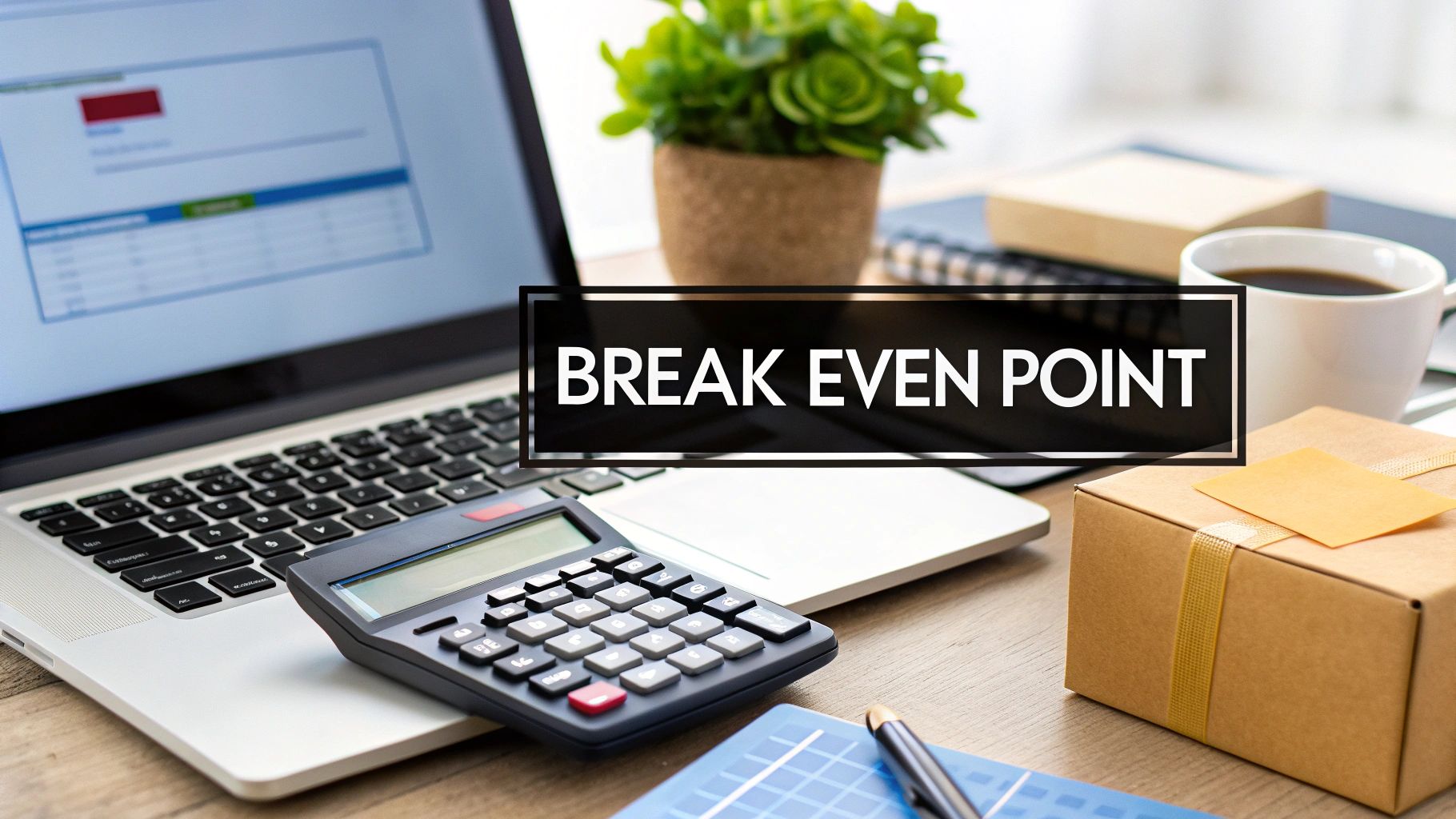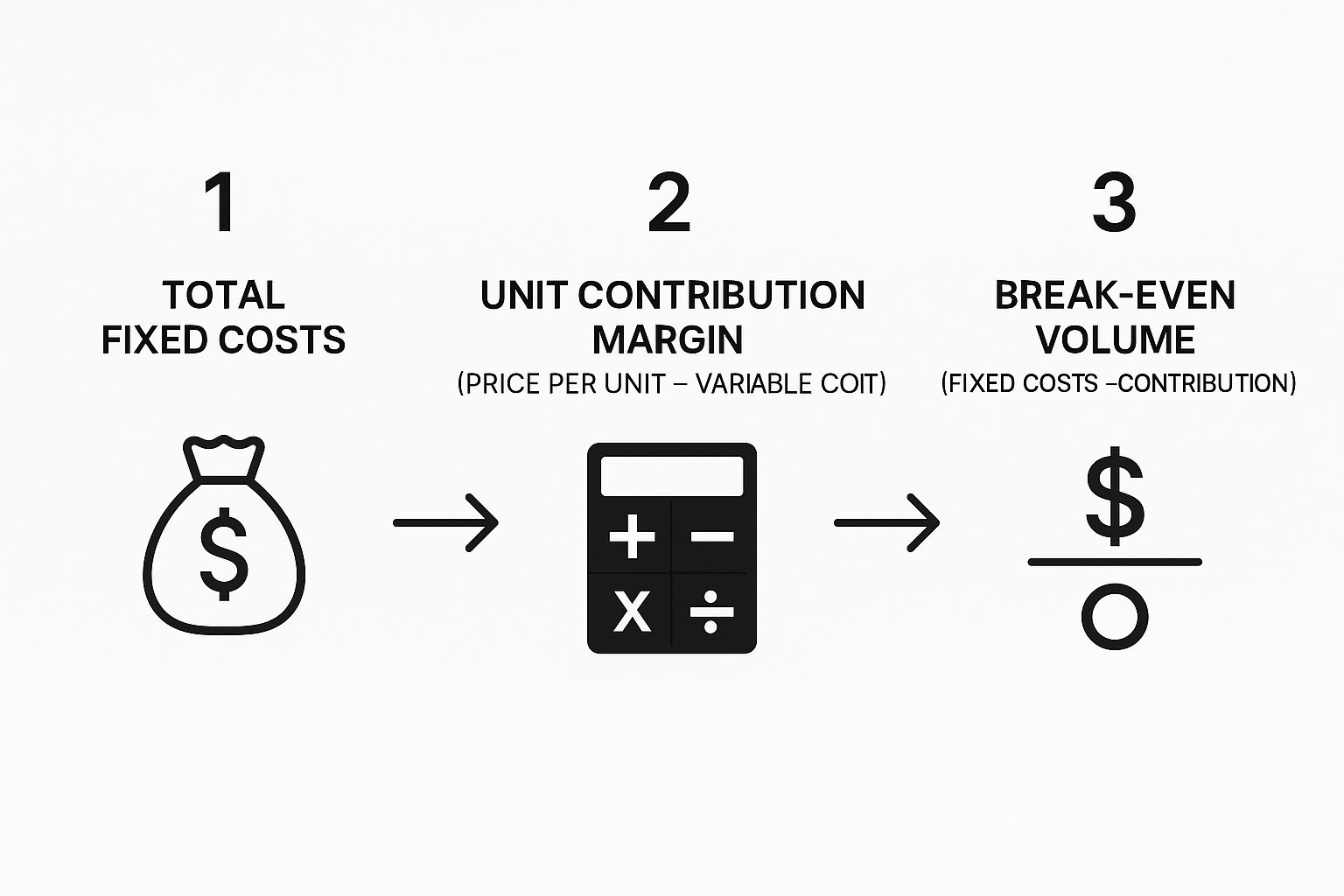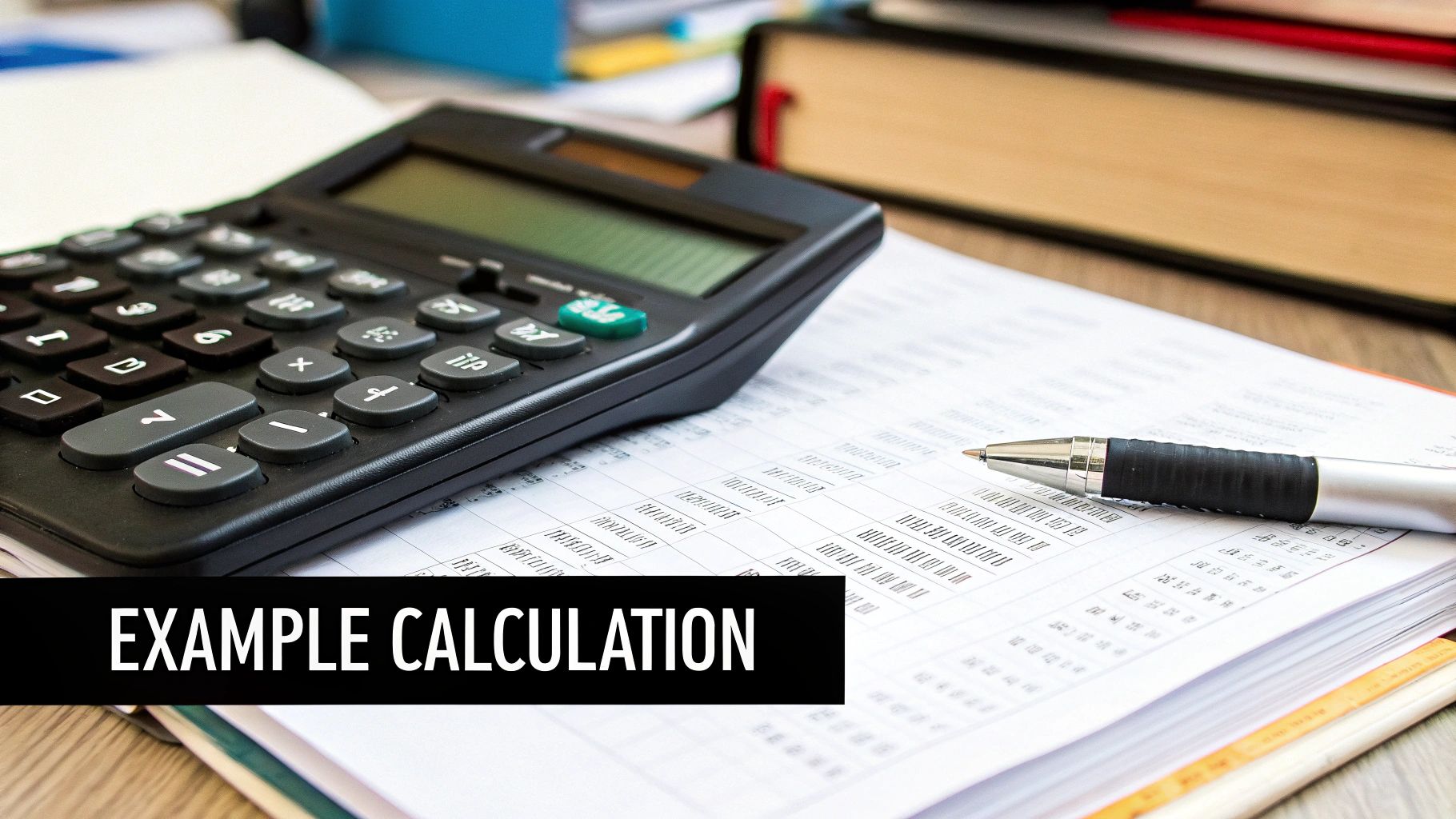Stay Updated with Everything about MDS
Thank you! Your submission has been received!
Oops! Something went wrong while submitting the form.

Chilat Doina
October 2, 2025
To figure out your break-even point, you just need to divide your total fixed costs by your contribution margin. The contribution margin is simply your selling price for one item minus the variable cost for that same item. This straightforward calculation tells you the exact number of units you need to sell just to cover all your bills, without making a profit or a loss.
Let's cut through the jargon. The break-even point is that magic number where your total sales perfectly cover your total costs. You're not losing money, but you're not exactly making a profit yet, either.
Think of it as the financial starting line. For e-commerce founders, this isn't just some dusty accounting metric; it’s a vital health check for your business. It tells you, in no uncertain terms, precisely how much you have to sell just to stay afloat.
Getting a handle on concepts like this starts with a solid foundation in your numbers. If you feel like you're playing catch-up, there are great resources out there on mastering basic accounting for small businesses.
Before we get to the formula, you need to have a few key pieces of information pulled together. These are the fundamental building blocks of your break-even analysis.
Here's a quick rundown of the essential terms you'll need to know.
Having these numbers handy is the first, most crucial step. Once you've got them, the rest is just simple math.
This isn't a new concept, by the way. It’s a tried-and-true principle from managerial accounting that popped up in the early 20th century when businesses were looking for better ways to forecast profitability. The fact that it's still so essential today, even with all our advanced analytics, just goes to show how fundamental it is to running a healthy business.

Alright, let's get into the mechanics. The math behind your break-even point is refreshingly simple—no finance degree required. You can look at it in two main ways: by the number of units you need to sell, or by the total sales revenue you have to bring in.
This is the classic approach and probably the most common. It gives you a crystal-clear target: exactly how many products you need to get out the door to cover your costs. It’s perfect for brands with a pretty straightforward product line.
Here’s the formula: Break-Even Point (Units) = Total Fixed Costs / (Selling Price Per Unit - Variable Cost Per Unit)
See that bottom part of the equation? (Selling Price - Variable Cost) is what we call your contribution margin. This is the slice of profit you make from a single unit before you factor in all your fixed overhead. If you want to really get a handle on this critical number, check out our guide on what gross margin is and how to calculate it.
Think of it this way: you’re just figuring out how many times you need to earn that single-unit profit to pay off all your monthly bills. It’s a powerful way to frame your sales goals.
Key Takeaway: Every sale you make "contributes" a piece of its profit toward paying down your fixed costs. Once those are covered, every subsequent sale contributes directly to your net profit.
Sometimes, focusing on a specific number of units isn't practical, especially if you sell a wide variety of products at different price points. In that case, aiming for a total revenue target makes more sense.
Here’s how you calculate that: Break-Even Point (Sales Revenue) = Total Fixed Costs / Contribution Margin Ratio
The Contribution Margin Ratio is just your contribution margin shown as a percentage of your selling price.
Let's say a business has $10,000 in fixed costs, a selling price of $15, and variable costs of $5 per unit. A quick calculation shows they'd need to hit about $14,925 in revenue to break even. This ratio-based formula gives you a bird's-eye view of the sales target you need to hit to stay out of the red, which is incredibly useful for high-level planning.
Theory is great, but let's get our hands dirty and see how this actually works.
Imagine an e-commerce brand we'll call "Lumen & Co." that sells artisanal, hand-poured candles. To figure out their financial baseline—the point where they stop losing money and start making it—they need a crystal-clear picture of all their costs.
First up, we'll tally their fixed costs. These are the bills they have to pay every single month, whether they sell one candle or a thousand.
Add it all up, and their total fixed costs come out to $550 per month. This is the mountain they need to climb each month before a single dollar of profit is made.
Next, we need to nail down the variable costs—these are the expenses tied directly to producing one single candle.
So, the total variable cost per candle is $9.00. Lumen & Co. has priced each candle at $25. With these numbers, we've got everything we need to plug into the formula.
This handy visual shows exactly how all these pieces fit together to find that magic number.

As you can see, you just subtract your variable costs from the sale price to get your contribution margin. Then, you divide your fixed costs by that margin to find your target.
To make it even clearer, here’s a table that lays out the entire calculation for Lumen & Co.'s candle business.
This step-by-step breakdown gives you a repeatable blueprint for your own e-commerce store.
Now, let's officially plug these numbers into the break-even point formula:
Break-Even Point (Units) = Total Fixed Costs / (Selling Price - Variable Cost)
BEP = $550 / ($25 - $9)
BEP = $550 / $16
BEP = 34.375 units
Of course, you can't sell a fraction of a candle. So, Lumen & Co. has to round up. They need to sell 35 candles every single month just to cover their expenses.
Every candle sold after that 35th unit is pure profit.
Understanding this number is a game-changer. It’s not just about covering costs; it’s about knowing the exact moment your hard work starts paying off. This insight is foundational to your brand's financial health. For a deeper look at what comes next, you should explore guides on the profit margin calculation formula.
This simple, repeatable process transforms abstract financial theory into a concrete sales target you can actually hit every month.

Knowing how to calculate your break-even point is just the starting line. The real magic happens when you turn this static number into a dynamic tool for making smarter, data-backed decisions about where your e-commerce business is headed.
Think of it as your own financial simulator. Before you actually commit cash to a big move, you can run the numbers and see exactly how it will affect your profitability. This shifts you from guessing to forecasting, letting you manage risk and steer your brand toward sustainable growth with real confidence.
Let’s walk through a few real-world situations that e-commerce founders face all the time. By tweaking the variables in your break-even formula, you can get a surprisingly clear picture of what a strategic move might look like.
Launching a New Ad Campaign: Say you want to bump your monthly ad spend by $1,000. This directly increases your fixed costs. You can instantly calculate how many more units you need to sell just to cover that new expense, which helps you set a realistic ROAS (Return on Ad Spend) target from the get-go.
Changing Suppliers: You found a great new sustainable supplier, but using their materials increases your variable cost per unit by $2. Your break-even analysis will show you precisely how this hits your contribution margin and how many more sales you'll need to stay in the same financial spot.
Offering a Discount: Planning a 20% off sale for Black Friday? This temporarily drops your selling price per unit. Running a quick BEP calculation for the sale period helps you understand the sales volume you must hit to make the promotion profitable, keeping you from accidentally running a loss-leader.
Your break-even point isn't a "set it and forget it" metric. It should be a living number you consult before making any significant changes to your pricing, marketing spend, or operational costs. This proactive approach separates thriving businesses from those that struggle.
Slashing your costs is one of the most direct ways to lower your break-even point, making it that much easier to get into the black. Even small efficiencies can make a huge difference to your bottom line.
Take a company with fixed costs of GBP 550,000 and a product priced at GBP 100. If their initial variable costs are GBP 60 per unit, their break-even point is 13,750 units. But by optimizing their supply chain, they get the variable cost down to GBP 40. Suddenly, their break-even volume drops to just 9,167 units.
That’s a 33% reduction in the number of sales they need to make just to cover costs. It's a powerful example of how small operational tweaks can drastically lower your financial hurdles. To dig deeper into practical ways to trim expenses, you can check out our detailed guide on https://milliondollarsellers.com/blog/cost-reduction-strategies.
By modeling these kinds of scenarios, you transform a simple calculation into a powerful strategic planning tool. To see how break-even analysis fits into your wider growth plans, you can also explore more on business growth and strategy.

Knowing your break-even point is a huge advantage, but one tiny mistake can make the whole exercise pointless. In fact, a bad BEP calculation is often worse than having no BEP at all, because it can trick you into making strategic decisions based on completely flawed numbers.
Even experienced founders can get tripped up by a few common hurdles. The biggest challenge? Getting your cost classifications right. It's surprisingly easy to make a small error that throws off your entire calculation, so let's walk through the most frequent slip-ups and how to avoid them.
The most common pitfall I see is incorrectly sorting fixed and variable costs. It sounds simple, but a lot of expenses don't fit neatly into one box. They live in a gray area known as semi-variable costs.
Think about your marketing agency. They might charge a $2,000 monthly retainer (a fixed cost) plus a 10% commission on ad spend (a variable cost). If you just lump that entire expense into one category, your BEP will be off.
Another classic mistake is treating all marketing spend as a fixed cost. Sure, you might set a monthly budget, which feels fixed. But performance-based ad spend on platforms like Google or Meta is directly tied to sales volume, making it a true variable cost.
Your BEP is only as reliable as the data you feed it. Take the time to meticulously audit and classify every single expense. A few minutes of extra diligence can save you from months of chasing the wrong financial targets.
Next up are the sneaky little costs that quietly eat away at your margins. These often fly under the radar during a quick calculation but can seriously impact your break-even point.
You have to account for them.
Once you’ve got the break-even calculation down, you start thinking about the real-world messy parts. It’s a sign you’re moving from theory to action, which is exactly where you want to be. Here are a couple of the questions I hear most often from founders.
Think of your BEP as a living number, not a "set it and forget it" metric. You absolutely need to run the numbers again anytime a major variable shifts.
Did your biggest supplier just raise their prices? Is your 3PL charging more for fulfillment? Did you just hire a new team member and add to your fixed costs? Or maybe you just changed your product pricing. All of these are perfect triggers to recalculate.
As a general rule of thumb, it’s smart to revisit your break-even point quarterly. It keeps the number fresh and genuinely useful for making sharp decisions.
This is where most people get tripped up. If you have a whole catalog of products with different prices and margins, a single, simple BEP formula for the whole business won't cut it.
The solution is to calculate a weighted average contribution margin. This sounds more complex than it is. You’re essentially figuring out the average profit per unit based on your sales mix—the proportion of each product you typically sell. That new average number gets plugged into the standard BEP formula, giving you a much more accurate, blended result for your entire business.
A quick sanity check: if you ever run the numbers and get a negative break-even point, something is wrong. It's not a real-world possibility. A negative BEP means your contribution margin is also negative, which tells you you're actually losing money on every single sale. This is a massive red flag that your pricing is way too low or your variable costs are out of control.
At Million Dollar Sellers, we're all about using data like this to build stronger, more profitable businesses. Our exclusive community is built for top e-commerce entrepreneurs who share these kinds of insights to scale smarter and faster. Apply for membership to join the conversation.
Join the Ecom Entrepreneur Community for Vetted 7-9 Figure Ecommerce Founders
Learn MoreYou may also like:
Learn more about our special events!
Check Events